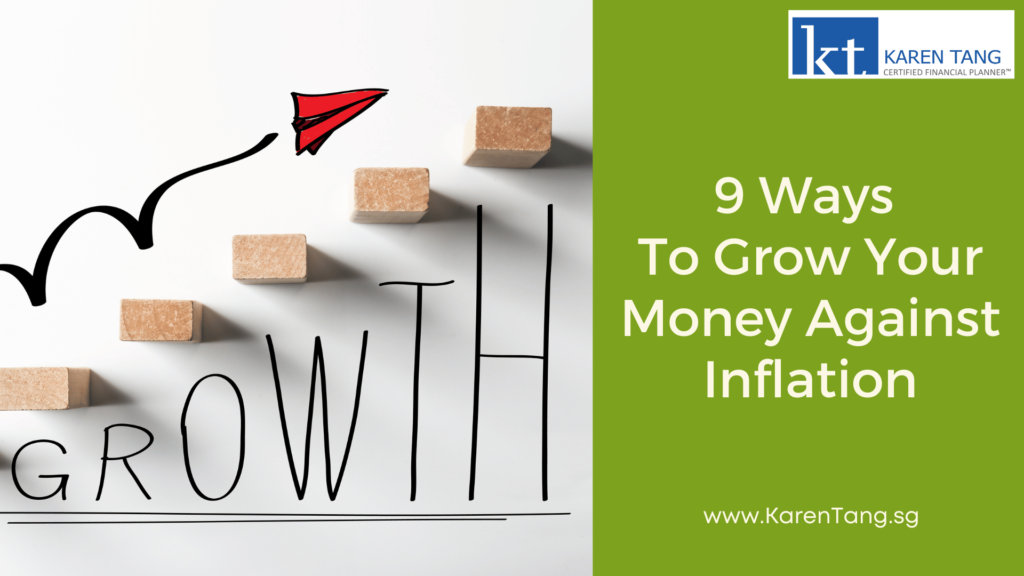Karen Tang, CFP®: Certified Financial Planner in Singapore
9 Ways To Grow Your Money Against Inflation

One key take away from the current inflation environment is that low inflation is by no means guaranteed. Inflation will never go away. But what you and I can do to preserve our buying power is to ensure our money grows beyond the inflation rate.
Growing money against inflation requires strategies that suit your financial goals, risk profile and time horizon.
Here are several ways to achieve this goal:
- Invest in Stocks
This is an asset class that many people are familiar with. Stocks have, historically, outperformed inflation over the long term. When selecting stocks, look out for companies that have solid fundamentals and good prospects for growth. A cardinal rule of successful investing is to diversify your portfolio across different sectors to mitigate risks. Stocks and volatility go hand-in-hand so be sure to have a clear understanding of what you are investing in. - Invest in Bonds
This is an asset class that can provide a higher return alternative to fixed deposit accounts. You can put your money in Government backed bonds, bond ETFs and unit trusts which invest in different segments of the bond market – government bonds, investment grade corporate bonds, high yield bonds, etc. - Invest in Unit Trusts
Unit trusts (collective investment schemes) are professionally managed and they are a convenient and (can be a) cost effective way to invest your money in various underlying asset classes such as stocks, preference shares, bonds, commodities, private companies and real estate. They give you global access to securities and bonds which you would otherwise have to invest through the stock exchanges. A unit trust investment portfolio allows for easy diversification and your money is liquid. - Invest in Real Estate
Real estate is a tangible asset that tends to appreciate in value over time. It is a favoured asset class by many as property values and rental income rise with inflation, making it a good hedge. However, a big ticket item like property requires a significant six-figure down payment, making it a rather inaccessible asset class. An option to still participate in real estate is to consider investing in residential or commercial properties or real estate investment trusts (REITs) that own and manage income-generating properties. - Invest in Commodities
Certain commodities, like gold, silver, and oil, have historically been considered ‘value store houses’’ during inflationary periods. Have not your grandparents and great grandparents told you to invest in gold? Well, they are not wrong. However, this does not mean that commodities are not subject to volatility. Proceed with an understanding of the risks involved. - Invest in Inflation-Indexed Annuities
I have come across such annuities but they are not available all the time. Such plans provide a guaranteed income stream and payments are adjusted based on inflation every year. They can be a suitable option for those seeking a stable income that keeps pace with inflation. - Diversify
Don’t put all your eggs in one basket. This is the single most important tenet in investing. By spreading your investments across various asset classes, you can reduce risk and maximise the chances of growing your wealth. Diversify your portfolio across stocks, bonds, real estate, and other asset classes to mitigate the impact of inflation on your investments. - Invest Regularly (Dollar Cost Averaging)
Consistently saving and investing a portion of your income can help you combat inflation. Dollar cost averaging is automatic and it helps to remove the pitfalls of market timing. This ‘no brainer’ method takes the emotions out of investing and prevents you from making rash, uninformed decisions. By regularly adding to your investments, you can reap the rewards of compounding returns over time. - Review and Adjust
It is a good practice to review and rebalance your investment portfolio regularly, for example, once or twice a year. Make changes to your asset allocation as economic, geopolitical conditions and inflation expectations change. This will help to ensure that your portfolio remains diversified and that you are still on track to reach your financial goals. Discuss with your trusted financial advisor to take the next step forward.
To sum it up, investing involves risks. It is vital to take into consideration your current circumstances, financial goals, risk tolerance, and time horizon before making important investment decisions. When in doubt, consult with a qualified professional who can provide guidance based on your needs.
To beating inflation! To growing your wealth!
CATEGORIES
KAREN'S LATEST BLOGS
Latest Blog Posts

Financial Coaching: Why It’s Becoming Essential in Singapore
Let’s face it – living in Singapore is expensive. Between the rising costs of housing, daily living, and societal pressures to “make it,” it’s easy

Secure Your Legacy: Estate Planning Essentials for Women in Singapore
When it comes to planning for the future, estate planning often takes a backseat to more immediate financial goals, such as saving for a home

2025: The Year You’ve Been Waiting For!
Happy New Year, my dear friends! Wishing you a wonderful beginning to 2025—a year filled with boundless opportunities and meaningful experiences! Starting the year on
